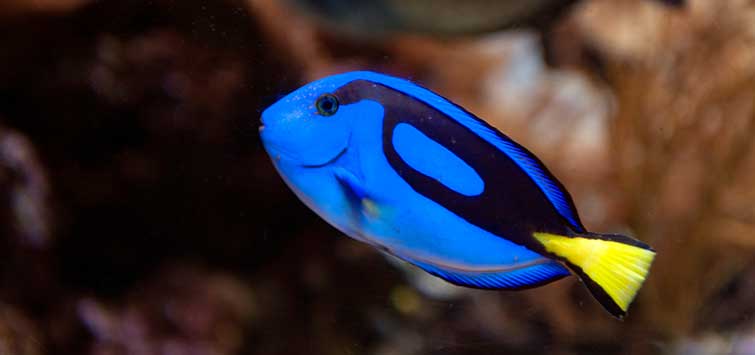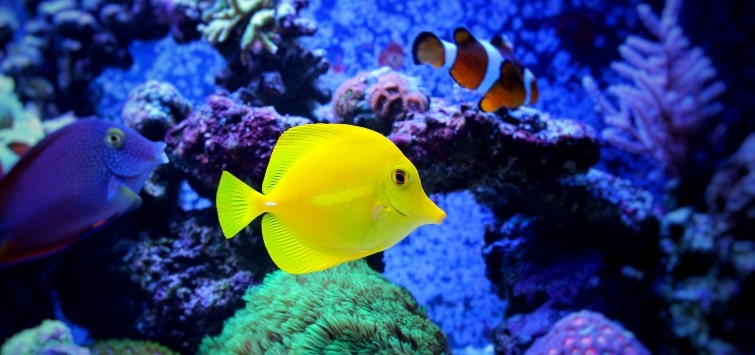Tips and Tricks for Keeping Tangs
Author: Richard Aspinall
Tangs are a mainstay of the saltwater aquarium because they are attractive, long-lived, and can be found throughout the world’s tropical oceans. There are few marine hobbyists who won’t have kept at least one tang during their time in the hobby. And there are even fewer who won’t have a warning tale or two resulting from their experiences. Make no mistake: Tangs are not easy fish to keep! But knowing some tricks will increase your chances of success.
Tangs in the Wild
If you want to understand what a fish needs in captivity, the first thing to know is how it lives in the wild. Only then can you ensure that you are replicating the conditions that allow the fish to thrive in a home aquarium.
In the wild, tangs roam across large areas of reef systems. They are constantly on the move and almost always grazing on marine algae as they go. Given that algae grow in the most brightly lit areas of a reef, tangs are found in shallow reef waters, mainly on the reef crest, and on occasion, grazing on lush algal growths on the reef flat. These areas are constantly exposed to a great deal of water movement caused by surface currents and waves. Aquarists need to replicate this movement and maintain excellent water quality and as much swimming room as possible.
Getting the Tank Right
A fundamental question to consider before attempting to keep tangs is whether your tank is suitable. Tangs are very mobile fish, and a spacious tank can help dissipate aggression among individuals.
On occasion, I have seen very young tangs in small or even nano aquariums. Small Pacific blue tangs (Paracanthurus hepatus) or even sailfins (Zebrasoma veliferum) are appealing and easy to import and to maintain in a dealer’s tank, but in my opinion they should never be kept in tanks under 100 gallons (378 liters).
Tangs are often seen swimming in shoals in the wild, sometimes mixed with similar species or in mated pairs. This is something that you are not going to successfully replicate in captivity. For example, a shoal of sohal tangs (Acanthurus sohal) are fine on a Red Sea reef flat, but in an aquarium, this is a recipe for disaster. Some of the smaller species, like yellow tangs (Z. flavescens), can be kept in groups but only in large tanks of 300 gallons (1136 liters) or more, and even then only when all of them are roughly the same size and added to the tank at the same time.
Species Selection and Tankmates
Tank Size
Tanks over 100 gallons (378 liters) can easily accommodate powder blue (Acanthurus leucosternon), Pacific blue (P. hepatus), and purple tangs (Z. xanthurum) with ease. With an increase in tank size, sailfins (Z. veliferum and Z. desjardinii) can also be kept. Other choices include significantly larger fish like the orange shoulder tang (A. olivaceus), the lieutenant tang (A. tennentii), and even—if your tank is very large (400 gallons [1514 liters] or more)—the naso (Naso lituratus) or sohal (A. sohal) tang. However, these latter species can be quite a handful and will assert their dominance in an aquarium.
Armor
Tangs can be feisty creatures, and they are well armed. They possess a sharp, scalpel-like structure on their caudal peduncles (where the tail joins the body) that is used by the fish in defense or for aggression against predators, as well as to establish territories. In captivity, dominant tangs can quickly harm submissive fish and drive them into hiding, and as a result of stress and starvation, ultimately lead to their death.
Acclimation
Experts often recommend that hobbyists add tangs to an aquarium last. This advice should be followed whenever possible. I have known expert fishkeepers to plan their tang purchases carefully so they can keep multiple tang species in their very large tanks, taking months to procure and complete their collections.
Aggression
Tangs do not limit their aggression to other tangs; they will also attack similarly shaped and sized fish. Adding angelfish (family Pomacanthidae) or butterflyfish (family Chaetodontidae) to an aquarium with an adult tang in residence can be problematic, but certain techniques can make cohabitation easier in these situations. You might try changing the aquascaping to disrupt a fish’s territorial behavior or placing a divider in your tank to allow the newcomer to establish itself.
Water Quality
As noted, water quality and movement are critical to ensuring that your tangs are healthy and happy. If you get the water right, then many other good things will follow. A lot of water movement will replicate a tang’s natural environment and also help maintain water quality in combination with efficient physical filtration.
With their penchant to eat continuously throughout the day, tangs need a tank with a powerful filtration system. If you’re worried that your existing skimmer won’t be strong enough, then assume that it isn’t and see your new additions as an opportunity to upgrade. You may also want to keep a set of spare parts on hand, just in case your skimmer fails.
Ozonizers
I would also look into adding a small ozonizer to your system. Ozone has multiple benefits, from speeding up the breakdown of organic pollutants to discouraging pathogens and parasites. However, make sure the unit’s controller is reliable and regularly calibrated, since ozone overdose can wipe out your entire tank in a matter of hours.
Chemical Filtration
Chemical filtration also plays a significant role in an aquarium, as does a refugium to absorb the significant amount of nitrates and phosphates that tangs can generate—especially if you’re keeping a collection of corals, which can suffer at detectable phosphate levels.
Feeding
I’ve come across several accounts relating that the digestive systems of tangs are inefficient, which would explain why they have to eat so much. But this conclusion is slightly missing the point: Although material passes through a tang’s gut quickly, the fish is adapted to an environment with ubiquitous marine algae, making its digestive system perfectly suited to steady grazing. With this in mind, I suggest that many tangs are underfed in captivity and regularly fail to reach the size they would in the wild as a result.
While algae form the bulk of their food source in the wild, tangs in captivity will take meaty foodstuffs such as mysis and brine shrimp. Their staple diet should consist mainly of marine algae and even occasional treats from the refugium. Many sources in hobbyist literature suggest that terrestrial greens, such as spinach and lettuce, are too low in protein and vitamin content to be of any value. Dried algae sheets specifically prepared for fish, or even nori sheets, can be soaked in or treated with supplements to increase their nutritional content. Tangs also enjoy flaked foods, especially those rich in algae.
In-Store Fish Selection
How can you recognize a healthy tang? First, avoid fish with obvious signs of disease, such as white spots and marks on the body, markedly damaged fins, cloudy eyes, lesions, or rapid breathing. Then look for a specimen that has plenty of flesh covering its bones; a skinny fish with a pinched appearance is at risk for infection.
By only acquiring well-fed, healthy fish, you are encouraging your local shop to take good care of its charges while sparing yourself the heartache and wasted money of an unhealthy specimen. In my opinion, cheap fish are often bad investments that damage the hobby’s reputation as a whole. Some dealers will also sell very young fish, and while a 2-inch (5-cm) Pacific blue tang (P. hepatus) will adapt well to aquarium life, as it grows, its behavior, including its aggression level, will change dramatically, so do your research and choose wisely.
Disease
Sadly, tangs are prone to disease and will often be the first fish in a tank to show signs of infection, often as a result of stress brought on by poor water quality. As always, an ounce of prevention is better than a pound of cure, so keep your skimmer maintained and run an ozonizer to eliminate infectious organisms in the water column. Diet is also important, and a well-fed fish is better able to resist disease.
Marine head and lateral line erosion (MHLLE) is a poorly understood disease that can be an issue for tangs, causing soft-tissue damage to the head and lateral line area. In some cases, it can also damage the tissue between the dorsal fin rays. Activated carbon has been widely considered the culprit, although many aquarists use carbon without MHLLE being seen. I have known aquarists who lost collections of tangs to unknown diseases with no obvious cause.
The best way to protect your fish is to use a quarantine tank to ensure that new purchases are free of infection and parasites. You should also ask your fish dealer if the specimens you’re planning to buy have been treated to kill any intestinal parasites. But again, to be safe, always quarantine your new acquisitions before adding them to the main tank to ensure that they are feeding and healthy.
Keeping It Real
I hope this information doesn’t dissuade you from keeping tangs; they only present problems when aquarists fail to provide them the proper environment and conditions they require in captivity. There is nothing to their captive care that is impossible to provide, as long as hobbyists are realistic about their skills and abilities and choose tangs that are appropriate for their saltwater system and the other fish that inhabit it.

.png?h=595&iar=0&w=2781&hash=5FD5E69473BCC22199FBFA2FB71B6033)



